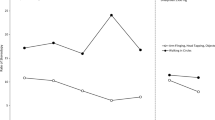Abstract
In Experiment I, the effects of a verbal warning, such as is used in Overcorrection, delivered contingently on the stereotyped mouthing behavior of two autistic/retarded children were examined. A multiple baseline design across subjects was used. The results indicated that the mouthing of one child was reduced to a nearzero level and mouthing of the second child was moderately reduced. Appropriate toy play and inappropriate object manipulation failed to show systematic changes in occurrence when mouthing was decelerated. In Experiment II, the same subjects and experimental design were used to assess the effects of a positive practice Overcorrection procedure delivered contingent on mouthing behavior. Overcorrection reduced the mouthing of both subjects. There were no systematic changes in inappropriate object manipulation but one subject did demonstrate an increased occurrence of appropriate toy play. In addition, this subject often engaged in aggressive/escape behaviors during Overcorrection, suggesting that the procedure was aversive to him.
Similar content being viewed by others
Reference notes
Doke, L. A., & Epstein, L. H.Oral overcorrection: Side effects and extended applications. Paper presented at the seventh annual convention of the Association for the Advancement of Behavior Therapy, Miami, December 1973.
Herendeen, D. L., Jeffery, D. B., & Graham, M. L.Reduction of self-stimulation in institutionalized children: Overcorrection and reinforcement of nonresponding. Paper presented at the eighth annual convention of the Association for the Advancement of Behavior Therapy. Chicago, December 1974.
Fog, J., Boyles, C., & Gill, K.The application of Overcorrection procedures to the treatment of self-stimulatory behavior in a profoundly retarded girl. Paper presented at the annual convention of the Southeastern Psychological Association, Atlanta, April 1975.
References
Azrin, N. H., & Holz, W. C. Punishment. In W. K. Honig (Ed.),Operant behavior: Areas of research and application. New York: Appleton-Century-Crofts, 1966. Pp. 213–270.
Azrin, N. H., Kaplan, S. J., & Foxx, R. M. Autism reversal: Eliminating stereotyped selfstimulation of retarded individuals.American Journal of Mental Deficiency, 1973,78, 241–248.
Baumeister, A. A., & Forehand, R. Effects of contingent shock and verbal command on body rocking of retardates.Journal of Clinical Psychology, 1912,28, 586–590.
Baumeister, A. A., & Forehand, R. Stereotyped acts. In N. R. Ellis (Ed.),International review of research in mental retardation (Vol. 6). New York: Academic Press, 1973. Pp. 55–96.
Berkson, G., & Mason, M. Stereotyped movements of mental defectives: IV. The effect of toys and the character of the acts.American Journal of Mental Deficiency, 1964,68, 511–524.
Bijou, S. W., Peterson, R. F., & Ault, M. H. A method to integrate descriptive and experimental field studies at the level of data and empirical concepts.Journal of Applied Behavior Analysis, 1968,1, 175–191.
Doleys, D. M., Wells, K. C., Hobbs, S. A., Roberts, M. W., & Cartelli, L. M. The effects of social punishment on noncompliance: A comparison with timeout and positive practice.Journal of Applied Behavior Analysis, 1976,9, 471–482.
Epstein, L. H., Doke, L. A., Sajwaj, T., Sorrell, S., & Rimmer, B. Generality and side effects of overcorrection.Journal of Applied Behavior Analysis, 1974,7, 26–31.
Forehand, R., & Baumeister, A. A. Deceleration of aberrant behavior among retarded individuals. In M. Hersen, R. M. Eisler, & P. M. Miller (Eds.),Progess in behavior modification (Vol. 2). New York: Academic Press, 1976. Pp. 223–278.
Foxx, R. M., & Azrin, N. H. Restitution: A method of eliminating aggressive-disruptive behavior of retarded and brain damaged patients.Behaviour Research and Therapy, 1972,10, 15–27.
Foxx, R. M., & Azrin, N. H. The elimination of autistic self-stimulatory behavior by Overcorrection.Journal of Applied Behavior Analysis, 1973,6, 1–14.
Koegel, R. L., & Covert, A. The relationship of self-stimulation to learning in autistic children.Journal of Applied Behavior Analysis, 1972,5, 381–387.
Koegel, R. L., Firestone, P. B., Kramme, K. W., & Dunlap, G. Increasing spontaneous play by suppressing self-stimulation in autistic children.Journal of Applied Behavior Analysis, 1974,7, 521–528.
Lovaas, O. I., Litrownik, A., & Mann, R. Response latencies to auditory stimuli in autistic children engaged in self-stimulatory behavior.Behaviour Research and Therapy, 1971,9, 31–49.
O'Leary, K. D., & Becker, W. C. The effects of the intensity of a teacher's reprimands on children's behavior.Journal of School Psychology, 1968,7, 8–11.
Rimland, B.Infantile autism. New York: Appleton-Century-Crofts, 1964.
Risley, T. R. The effects and side effects of punishing the autistic behaviors of a deviant child.Journal of Applied Behavior Analysis, 1968,1, 21–34.
Ross, A. O.Psychological disorders of children: A behavioral approach to theory, research, and therapy. New York: McGraw-Hill, 1974.
Sachs, D. A. The efficacy of time-out procedures in a variety of behavior problems.Journal of Behavior Therapy and Experimental Psychiatry, 1973,4, 237–242.
Ulrich, R. E. Pain-aggression. In G. A. Kimble (Ed.),Foundations of conditioning and learning New York: Appleton-Century-Crofts, 1967. Pp. 600–622.
Author information
Authors and Affiliations
Rights and permissions
About this article
Cite this article
Wells, K.C., Forehand, R. & Hickey, K. Effects of a verbal warning and overcorrection on stereotyped and appropriate behaviors. J Abnorm Child Psychol 5, 387–403 (1977). https://doi.org/10.1007/BF00915087
Revised:
Issue Date:
DOI: https://doi.org/10.1007/BF00915087




